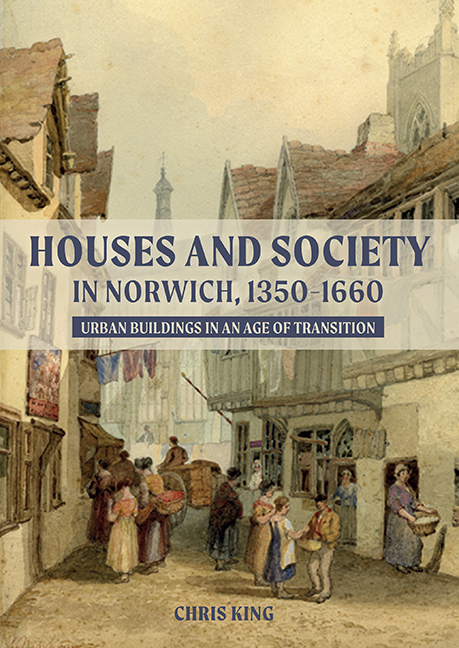Book contents
- Frontmatter
- Dedication
- Contents
- List of plates and figures
- List of tables
- Acknowledgements
- List of Abbreviations
- 1 Urban rebuildings, urban transitions
- 2 Norwich, 1350–1660: continuity and change in an English provincial city
- 3 Medieval merchants’ houses, c.1350–1540
- 4 Early modern merchants’ houses, c.1540–1660
- 5 The urban elite: domestic space, social identity and civic authority
- 6 Medieval houses and the urban ‘great rebuilding’
- 7 Houses of the ‘middling sort’: buildings and the use of space
- 8 Housing the urban poor and immigrant communities
- Conclusions
- Glossary
- Bibliography
- Index
- Plate Section
4 - Early modern merchants’ houses, c.1540–1660
Published online by Cambridge University Press: 23 October 2020
- Frontmatter
- Dedication
- Contents
- List of plates and figures
- List of tables
- Acknowledgements
- List of Abbreviations
- 1 Urban rebuildings, urban transitions
- 2 Norwich, 1350–1660: continuity and change in an English provincial city
- 3 Medieval merchants’ houses, c.1350–1540
- 4 Early modern merchants’ houses, c.1540–1660
- 5 The urban elite: domestic space, social identity and civic authority
- 6 Medieval houses and the urban ‘great rebuilding’
- 7 Houses of the ‘middling sort’: buildings and the use of space
- 8 Housing the urban poor and immigrant communities
- Conclusions
- Glossary
- Bibliography
- Index
- Plate Section
Summary
THIS chapter continues the discussion of the houses of the civic elite in Norwich into the early modern period, between c.1540 and 1660. It begins by following the development of the late medieval houses described in the previous chapter, examining the fate of the medieval open halls and the changes that were made to their private spaces and access arrangements. It will be shown that while some mercantile houses ceiled over the open hall and developed new ways of organising and using domestic space, others retained many aspects of their medieval past. The chapter then moves on to discuss the mercantile houses that were first constructed in the early modern period. There was a widespread phase of new building at this social level in the middle decades of the sixteenth century, from c.1520 to 1570. The new houses, in parallel with the modified medieval properties, adopt innovative plan forms and a range of distinctive spatial arrangements and architectural features. These elements continue to develop in the seventeenth century, although this period is characterised by the gradual adaptation of existing buildings rather than a widespread redevelopment of elite dwellings. The final section of the chapter draws together the evidence for both continuity and change in the merchants’ houses in the early modern period, considering these changes in terms of wider developments in elite architecture in this period.
Strangers’ Hall, Charing Cross, c.1540–1660
In 1540, as we have seen, Strangers’ Hall was the home of widow Agnes Sotherton, née Hethersett. She outlived her husband by 36 years, dying in 1576. The Sothertons were one of the city's premier mercantile dynasties, with three generations holding high civic office. Of Nicholas’ and Agnes’ three sons, Thomas was mayor in 1565, Leonard was sheriff in 1556 and John was sheriff in 1565. Thomas Sotherton resided in St Andrew's parish and John occupied Strangers’ Hall after his mother's death; the two brothers were both married to daughters of Augustine Steward. John’s eldest son Thomas, who was burgess in parliament in 1596 and mayor in 1605, seems to have lived in the neighbouring property and Strangers’ was occupied by his younger brother, John. Thomas Sotherton died and was buried in 1608 in St John Maddermarket (Kelly 2004).
- Type
- Chapter
- Information
- Houses and Society in Norwich, 1350–1660Urban Buildings in an Age of Transition, pp. 105 - 144Publisher: Boydell & BrewerPrint publication year: 2020



